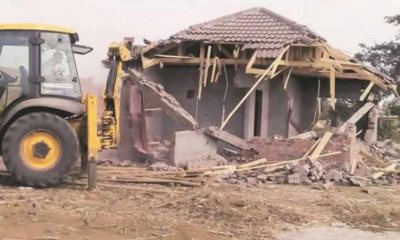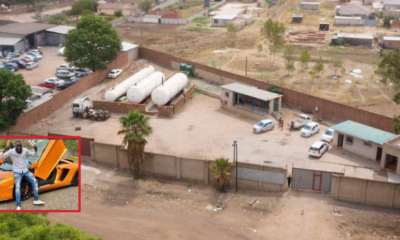
Opinion
The ‘silent’ dispossession of customary land rights holders for urban development in Zim
Published
3 years agoon
By
NewsHawksPHILLAN ZAMCHIYA/OWEN DHLIWAYO/CYNTHIA GWENZI/CLARIS MADHUKU
THE dominance of and preoccupation with the radical repossession of largely white-owned commercial farms – since 2000 – for reallocation to millions of black families, although very important, has occluded attention to contradictory but silent processes of state-led dispossession of black communities living under communal tenure systems in Zimbabwe’s rural areas.
We intended to unravel this process through an empirical study of Munyokowere, Mahachi and Kondo villages as well as Checheche growth point, located in the lowveld of Chipinge district.
We reached out to 117 women and 39 men through interviews, focus group discussions (FGDs) and community meetings from December 2020 to January 2021. In these study sites, the state appropriated communal land to realise its vision of building modern urban areas but with consequences for the vulnerable and poorest social groups, such as women.
We observed that the Zimbabwean state, which prides itself in the politics of decoloniality, is dusting and making live colonial master-plan maps rooted in authoritarian high modernism ideologies, which were meant to dispossess the black communities of their prime land, to dusty and mountainous areas.
In Munyokowere, the state was using the colonial master plans of the 1950s to displace indigenous families.
On the other hand, in Mahachi the state dusted failed urban development plans, anchored on the 1982 Transitional National Development Plan (TNDP).
The TNDP intended to modernise the countryside through a transition from villages to rural service centres, district service centres, growth points, towns and cities, which entailed changes in land tenure systems.
It was within that context that Checheche was gazetted by government in 1982, with an initial total of 1 055 hectares.
However, the plan has been lying idle because such grandiose growth point plans in the country had “remained more in planners’ imaginations than in reality”. It was only at the turn of the millennium that there was renewed state interest.
This was partly driven by new investments, rent-seeking behaviour and state officials’ high modernist visions. Such investments included large-scale production of sugar-cane by Macdom Investments (Private) Limited and the manufacturing of anhydrous ethanol by its sister company Green Fuel in Chisumbanje, which is about 10 kms from Checheche.
As Blessing Mamvosha, the chief executive officer (CEO) of Chipinge Rural District Council (CRDC) explained: “The coming of Green Fuel’s ethanol plant at Chisumbanje made everyone excited and we had to plan a new Checheche”.
The new plan was that, “by end of day, the old and new Checheche ‘city’ shall be 2,203ha in total”. The CRDC needed to acquire adjacent communal land in order to realise its grandiose vision of a new city.
This land has been occupied by villagers in good faith for decades. In terms of the Communal Land Act (CLA) of 1982 governing communal lands, the President can make declaration to convert communal land to state land.
The responsible Minister can also set aside communal land for public purposes.
Other respondents attributed the new interest to the increasing rent-seeking behaviour by local authorities in the context of drying financial revenues due to the worsening national economic crisis.
According to the CEO, the council was “operating on a meagre budget of US$2.5 million per year”. Despite the failures of most growth points and small towns, the officials continued to place faith in the “merits of state planning” from above.
The Movement for Democratic Change Alliance (MDC Alliance) councillor for Ward 16, Rapheus Sithole, told us that as councillors they had made applications to the central state to convert communal land into state land.
The “silent” plans to establish new towns stretched across the lowveld covering areas such as Kondo, Maronga, Mwacheta, and Chipangara.
Wishes Hama, the MDC A councillor for Ward 24, stated that the vision was shared beyond political parties and that there was competition among the councillors to have the CRDC prioritise urban development in their respective wards. She said, “we agree on the vision for industry and urbanisation”.
In fact, Sithole complained that the central government was taking five to nine years to respond to applications to authorise development of rural service centres.
Such urbanisation dreams which were driven from above, blinded the realities of local landbased livelihoods and existing informal land rights for the majority who lived in the lowveld.
The dream Checheche had a detailed surveyed map of the terrain and an imagined synoptic view with standardised measures.
The map comprised of low-medium-high density residential areas reminiscent of big cities. There were business and industrial stands.
On the other hand, the city was going to have a market, bus terminus, town centre and a civic park for leisure. The government offices were factored in for effective state administration with two police posts to maintain law and order.
Not to be left out on the map were churches for worshipping. The reorganisation of Checheche on a map was an attempt at simplification of land rights, complex livelihoods and social practices.
There was no consideration of the agrarian landscape that had been existing for centuries.
For the planners, the smallholder farmers’ scattered field plots, grazing lands, meandering roads and homesteads did not offer aesthetic views.
They had to be demolished and be replaced with rectangular and square-shaped plots and straight roads all in line with the geometry of an urban modern city.
Hama was clear that, “in town you cannot farm”. Officials imagined a binary of rural and urban livelihoods, despite a corpus of evidence that shows interlinkages.
For example, they planned for movement of traffic that did not compete with donkeys. Yet the reality is that every time we drove into the growth point, we had to give way to herds of cattle, “stubborn” donkeys and ‘notorious’ goats and sometimes stray pigs grazing in the city centre.
The livestock also roamed and grazed in the leafy suburbs.
They forgot that in this kind of agrarian landscape, “for a small town to grow, the agricultural economy around it had to be vibrant and this could not be conjured up by grand plans”.
In China, Shanghai is redesigning to incorporate urban farming; Rotterdam in the Netherlands now has a farm for dairy cows; in Australia’s Melbourne, community gardens are thriving for lower-income households living in the city and in Seoul, South Korea, they are setting up urban farms.
We are not calling for “cut and paste” solutions, as conditions in Checheche are different and will require a territorialised approach.
The CRDC’s eviction process was authoritarian, arbitrary and unconstitutional. They hardly followed section 74 of the Zimbabwe constitution which states that: “No person may be evicted from their home, or have their home demolished, without an order of court made after considering all the relevant circumstances”.
For example, on 29 April 2019, the state served eviction notices to 750 families in Munyokowere. The state cited section 3 of the 2006 Gazetted Land (Consequential Provisions) which governs matters relating to the occupation of Gazetted land without lawful authority. However, on 24 July 2020, The High Court in Mutare granted an interdict to prevent the eviction, pending finalisation of the matter.
Nevertheless, the state was relentless in its bid to evict the poor and vulnerable. The same families in Munyokowere received another letter from the CRDC dated 1 September 2020.
It stated that: The land you have been occupying for some time now is within the Chipangayi Rural Service Centre under the administration of Chipinge Rural District Council …Consequently, you are advised to remove the illegal structure and vacate at your own cost within 90 days but in any event not later than 13 December 2020.
The CRDC encouraged Munyokowere villagers to apply for a stand but were reminded that the decision was at the Council’s “sole discretion”.
In many cases, the failure to adhere to the eviction notice resulted in violent evictions, destruction of livelihoods and loss of life. Utopian development visions seem to be always accompanied by an authoritarian force, but such practices are bound to be overtly resisted.
Sometimes people mobilised to protest and beat up the police and council officials who were destroying their properties. As Kundai Makata, a 28-year-old divorcee explained:
I teamed up with Shylock, Duncan and Sekai to beat people who were destroying our houses. I took a bemba [machete]. I removed my blouse and skirt in front of the police… I took papers from the Messenger of Court. A soldier from Chisumbanje slapped me but people started gathering and they ran away. They went to council and we followed and beat them up.
However, Sekai, Duncan and Shylock were later arrested, freed on bail and eventually fined by the magistrate’s court.
Council officials who wanted to peg council stands in Munyokowere were chased by villagers in December 2020. Others resorted to mobilisation and sensitisation meetings about people’s land rights, like the Platform for Youth and Community Development (PYCD).
Some partnered with the Zimbabwe Lawyers for Human Rights (ZLHR) for legal battles. From our interviews, an outstanding figure in the legal fight was Lovemore Madhuku, a distinguished academic who lectured law at the University of Zimbabwe, and President of the National Constitutional Assembly (NCA), who came from Chipinge.
Others fought spiritually and some even vowed to fight from the dead. As Feb Makhuyana attested, “when I die, I will come back as a spirit to my land”.
In this process, economic activities critical to day-to-day survival were destroyed. For example, the Dhliwayo family moved into Mahachi village in 1971.
They acquired 18 hectares of land through the traditional customs. They farmed 18-20 bales of cotton every season, had over 100 cattle and over 100 goats, hens, sheep and numerous donkeys.
Like many, the enclosure of common grazing land and arable land for urban development affected cropping and they had to relocate their livestock to Mozambique.
Even lives were lost. Maxwell Munyokowere said, “My brother Albert Munyokowere got high blood pressure, stroke and died. Muchirori committed suicide after getting eviction notice just after building his house in April 2020”.
Virginia Chimwamwa, a widow in Munyokowere had a similar story: “My husband died of stress. My son died of stress”. Eva Chipamuno said she suffered a miscarriage when authorities came with bulldozers to evict them on 3 December 2020 was a loser.
Those able to acquire the stands, were the elite, middle income groups, some traditional leaders, private players, speculators and those with strong political and social networks.
Section three of the application form emphasised the applicant’s occupation, income and available capital for developing the stand. Grace Jombo, a widow, said council officials were clear that, “this is for the rich and not for the poor”.
The prices for the stands were out of reach for many of the vulnerable women. A low-density stand cost USD13,800, medium-density USD 6,442 and high-density USD 2,300.
This is in a context where estimates suggest the number of extreme poor reached 7.9 million in 2020—almost 49% of the population, meaning this was out of reach for many.
Most beneficiaries were the locally employed, urban elites based as far as Harare and locals who worked in Johannesburg, South Africa and the local ‘big shots’.
The local “big shots” were largely connected to the ruling Zimbabwe African National Union Patriotic Front (Zanu PF) and this gave them power and authority over the allocation of land, sometimes challenging council authorities.
The council CEO acknowledged that the CRDC had agreements with private players to develop 3 500
residential stands in Checheche. Such private developers included New Vision, Zimbabwe Amalgamated Housing Association (Zaha) and Ramangwana Land Development Company.
Zaha was owned by Killer Zivhu, a staunch supporter of President Emmerson Mnangagwa and former Zanu PF Member of Parliament for Chivi South.
Most respondents believed Zaha benefitted because of Zivhu’s patron-client relations with the ruling elites. Some traditional leaders also benefitted from the process.
Lovemore Mahachi, the village head of Mahachi concurred, “I got 20 stands for free with my madhodha and we were expected to pay the lease and the rates.
Most of my council members sold the stands. I sold mine”. Lastly, there were local speculators connected to the Council, who acquired multiple stands for resale and sometimes sold one stand to many applicants in corrupt practices.
Long-term vulnerable residents who managed to apply and acquire land under the new tenure through agreements to pay in instalments were later displaced due to accumulation of debt.
For example, Febby Makhuyana, a widow, failed to pay lease rentals and fees from July 2013 to December 2019 for her stand number 503 in Phase 1 at Checheche growth point, stand services fees and instalments. In total, she owed CRDC US$3 010. CRDC planned to engage external debt collectors and the debt collection and legal fees were going to accrue to her.
This showed that formalisation could increase the rate of landlessness amongst the poorest and vulnerable.
The vulnerable who used their agency to buy land through the informal channels – a common practice amongst the poor across Africa – had their houses destroyed and stands repossessed with no effort at regularisation, therefore increasing the rate of homelessness.
The new property system became a machinery to redistribute land from the small to big owners who could leverage in real estate markets.
This resulted in a new land question of elite concentration. Here we are not talking of surplus labour being released to the imagined new industries.
The dispossessed could not be absorbed in the new urban areas and therefore were seen as “surplus” population. This seemed like a classic case of urbanisation without industrialisation.
This phenomenon was widespread in Zimbabwe and led to some urban proletariats to relocate to surrounding rural areas, or what others might call “off-grid” cities, like Goromonzi and Domboshava, where there were informal, flexible and less expensive tenure systems.
This is a phenomenon that is becoming widespread in contexts where African urban economies are failing to provide decent employment for the workers.
Due to the flexibility of customary tenure, some of the evicted people looked for new land through social relations in surrounding villages.
This inflow in communal areas and the annexure of fields for urban development was leading to changes from social to marketised tenure relations and the miniaturisation of small farms in some localities.
With scarcity of land, small farms were occupying less land but accommodating more people. Zvironzo Kondo, who was de facto village head in Kondo village, said that, “amidst land pressure we tell people to subdivide and share the farms.
Now they have small farms’. Related to this, is a change in land uses from food production to residential areas. This has led to a shift in livelihoods with many women now relying on the precarious informal sector.
Agnes Pahlo said, “we now cut trees to make bricks”. Others went to the nearby game park to fetch firewood for sale.
Eva Chipamuno noted that others were now going to work on estates like Makata estate farm where they cultivated bananas.
Miriam Chisinamwana elaborated: “I am buying and selling. I do not have enough land to farm. I sell cheap plastic shoes, satchels and clothes for kids”. Anna Mahachi said, “they were going to the river to get sand and sell”.
The urban development plans have also led to the rise in land markets and land prices in surrounding communal areas. Women now gained fields through the market rather than through social tenure.
As Lovemore Mahachi explained: “People survived through farming, but the growth point took their land. Now people rent fields in the adjacent communal area that belongs to Chief Garahwa”. Vester Taruwana from Mahachi said:
I cannot always rent a field because they want US dollars and rand. My husband goes to drink illicit beer so I cannot always afford. It costs R700 or US$35 to rent a hectare per season. However, we cannot measure the hectare; sometimes they cheat us. We rent in Ward 26 in Garahwa area. In Mahachi there is no more land to farm. In 2019, I did domestic work for others and saved money to rent a field in Ward 26. I planted maize and the sun [drought] destroyed everything. I did not harvest anything.
This might not be new but it is intensifying with the rising demand for customary land.
To our surprise, most of the women interviewed preferred to live under traditional communal tenure.
They detested state title deeds because one had to pay for rates, water, electricity and they had seen people defaulting and suffering.
In addition, the communal tenure system allowed them to own a house, a field and common property resources to support their multiple livelihoods.
From the field they could produce food for the family, grow crops like cotton to sell to raise money for school fees, among other family needs. They could also collect wild fruits, firewood and grass for thatching their huts, sand for brick-making in the shared forests.
The flexible tenure system allowed them to keep livestock and share grazing land. They felt that the individualised tenure systems would mean that they had to buy everything in a context where jobs were unavailable. Socially, they had networks and relied on reciprocity.
Chipo Sithole elaborated: “We cannot stay in town because it is each one for herself”. To them, the dispute resolution system under customary tenure was also cheap and easy to access. As Anna said, “In the village it is easy to get problems resolved. If we get a problem, we go to the chief.
If at night there is a problem, we go to the chief to get help”. In contrast, many said the councillors were not responsive to their needs and some of them were adjudged to be corrupt.
Some wanted customary tenure for cultural reasons. This is an area where there was ancestral veneration. Therefore, they wanted to look after ancestral shrines and to look after graves as they claimed that land also belonged to the dead. To them, changes in tenure systems would affect the dead.
We asked many of them whether the customary system they venerated was not oppressive to women. It dawned on us that custom was not static.
In the three localities of Kondo, Mahachi and Munyokowere the traditional leaders now allowed widows to inherit land and property. A respondent said: These days, if you are a widow and your son is claiming to inherit the homestead and saying you are an outsider, the chief calls the son and says, “Respect your mother; she is the one who looked for the land.” The chief tells your son that, “you cannot be a father when you are a child.”
Single women with children could also get land allocated to them. In addition, those who are divorced could get land from the village head. Zvironzo acknowledged that, “these days a lot of women [after divorce] demand land to live independently”. Women also now formed part of the traditional courts that dealt with dispute resolution. Mahachi said, “I love gender balance.
At my court there are four women and three men so that we do not discriminate against women in our hearings”.
There is a danger of romanticising the customary system. As we probed deeper, it became apparent from Mahachi, Zvironzo and Munyokowere that widows without children still faced eviction from their families.
Other losers were single women without children who found it difficult to acquire land independently, as they needed family approval.
Women who were divorced after accusations of “prostitution and witchcraft” were considered outcasts and in most cases could not easily get land.
In a few cases, they had to go through spiritual cleansing. This meant that patriarchy was still alive and real. Subsequently, we encountered three young women who preferred to opt out of the traditional system.
Others like Hama, advocated for a modern electoral system. She said, “traditional leaders are not voted for, so they do what they want. I want to stay in town where there are elected structures to govern. I want democracy where women can also participate”.
It is evident that we need more research to proffer wider and concrete solutions. However, given the rising demand for customary land, not only in Chipinge but across rural Zimbabwe, it is imperative for policy to clearly define land use rights.
Our view is that the Communal Land Act of 1982 vests too much power and authority over land in the Minister (Section 10), Rural District Councils and the President (Section 4 and Section 6). It is imperative for Zimbabwe to come up with a new Customary Land Act that shifts the balance of power from minister and President to citizens living on customary land.
We use “customary” consciously, as “communal” was a colonial construct to trump individual and family land rights holders.
In addition, the new Customary Act must legally recognise socially legitimate existing traditional occupation and good faith occupation by individuals, families and local communities who have been using the land for at least five years without the need to formalise, register and provide titles.
In such regard, attention must be paid to gender inequity, insecurity of widows, divorcees and single women. Customary land must not be literally interpreted in colonial parlance as reserve land for the state.
Once land use rights are transferred to the citizens – women and men alike – the next question is: who can dispose the right to land in the context of development projects?
Here we argue that no person must be deprived of their right to customary land in the absence of consent.
Lessons can be borrowed from South Africa’s Interim Protection of Informal Land Rights Act. Consent can be strengthened through ensuring that Zimbabwe’s ongoing land policy-making process strengthens the principle of Free, Prior and Informed Consent (FPIC), as applied in Zambia in 2021.
FPIC is an international principle that gives people the right to say yes or no to developmental projects, therefore upholding the universal right to self-determination.
If the customary land rights holders of Chipinge agree to urban development, then there is need to shift from the “dictatorship of the planner” to participatory and inclusive local planning that captures the lived tenure realities and agrarian-based livelihoods.
However, all these niceties can only work if there is an effective political strategy to counter power from below. Otherwise, the government will continue to manipulate customary tenure regimes, acting in alliance with private developers to produce exclusionary outcomes for the poor and vulnerable and to dispossess socially legitimate land rights holders.
About the writers: Dr Phillan Zamchiya is a senior researcher at the Institute of Poverty, Land and Agrarian Studies (PLAAS) at the University of the Western Cape in South Africa. Cynthia Gwenzi is a gender wellness and Advocacy officer at the Platform for Youth and Community Development (PYCD). Owen Dhliwayo is board secretary at PYCD. Claris Madhuku is director of PYCD.
You may like








